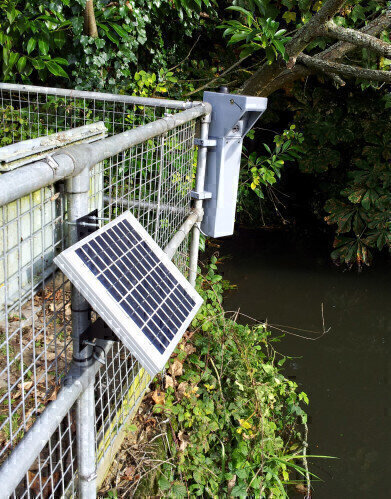Water/Wastewater
Self-sufficient camera gives public view of flood defence
Feb 25 2015
The challenge of protecting homes and businesses from future flood events, despite increased pressure on Government budgets, has received a shot in the arm with the roll out of a cost effective British made, maintenance-free camera system, that enables the public to take an active role in water level monitoring.
Utilising GPRS* wireless technology for transmitting high quality images both day and night in areas where there is no power source, the new cameras have been deployed by the Environment Agency (EA) at more than 50 high flood risk sites across Southern England. With pictures available on demand, the EA’s vast network of storm grilles and trash screens can be monitored remotely around the clock, eliminating the need for unnecessary inspection visits and thereby reducing the Agency’s carbon footprint.
Residents of one flood-prone village, Angmering in West Sussex, are early beneficiaries of the system. An image of the EA trash screen at the Black Ditch culvert entrance is linked directly to the Parish Council’s website, in real-time. The accessibility of information by the public can enable communities to prepare better in the event of extreme weather periods.
Designed by Hertfordshire based environmental monitoring specialists, Meteor Communications, the ‘Nexus’ camera is housed in a UK-manufactured stainless steel weather-proof pillar that can be installed and operational within 30 minutes. Explaining the reasons behind its development, Matt Dibbs, Managing Director of Meteor Communications, said:
“A lack of financial resources for flood defence projects has demanded an innovative yet cost-effective means of monitoring remote infrastructure. Existing methods require mains power, are often expensive to install and maintain and also susceptible to damage. The beauty of the Nexus remote camera system is its low power consumption, robustness and value for money. Our solar powered units achieve 100% autonomous operation, even in the most exposed areas.”
“Research has shown that climate change and the risk of further flood events are major areas of concern to communities across the country. By monitoring our waterways and flood defence infrastructure more cost effectively and giving visibility to the public using GPRS cameras, we can raise awareness and improve actions around this issue at the same time.”
In partnership with the Environment Agency, Meteor expects to install more than 100 cameras during 2015, at sites across the South West, Kent and stretches of the Thames from West London to Reading, which suffered serious flooding during the winter of 2013/14.
*General Packet Radio Service (GPRS) is a packet oriented mobile data service on the 2G and 3G cellular communication system’s Global System for Mobile communications (GSM).
Digital Edition
IET 34.2 March 2024
April 2024
Gas Detection - Biogas batch fermentation system for laboratory use with automatic gas analysis in real time Water/Wastewater - Upcycling sensors for sustainable nature management - Prist...
View all digital editions
Events
Apr 30 2024 Melbourne, Australia
Apr 30 2024 Birmingham, UK
May 03 2024 Seoul, South Korea
May 05 2024 Seville, Spain
May 06 2024 Minneapolis, MN, USA


















